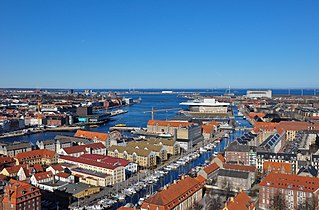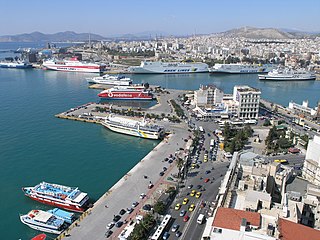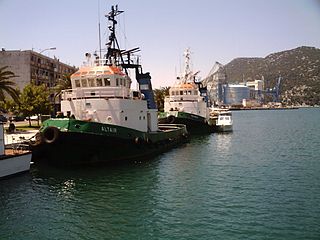
Chennai Port, formerly known as Madras Port, is the second largest container port of India, behind Mumbai's Nhava Sheva. The port is the largest one in the Bay of Bengal. It is the third-oldest port among the 13 major ports of India with official port operations beginning in 1881, although maritime trade started much earlier in 1639 on the undeveloped shore. It is an artificial and all-weather port with wet docks. Once a major travel port, it became a major container port in the post-Independence era. An established port of trade of British India since the 1600s, the port remains a primary reason for the economic growth of Tamil Nadu, especially for the manufacturing boom in South India, and has contributed greatly to the development of the city of Chennai. It is due to the existence of the port that the city of Chennai eventually became known as the Gateway of South India.
Kamarajar Port Limited, formerly Ennore Port, is located on the Coromandel Coast, Chennai about 18 km north of Chennai Port. It is the 12th major port of India, and the first port in India which is a public company. The Kamarajar Port Limited is the only corporatised major port and is registered as a company. Chennai Port Trust acquired around 67% stake of Centre in the Kamarajar Port Limited on 27 March 2020. The remaining 23 percent was already held by the Chennai Port Trust.

The Port of Savannah is a major U.S. seaport located at Savannah, Georgia. As of 2021, the port was the third busiest seaport in the United States. Its facilities for oceangoing vessels line both sides of the Savannah River and are approximately 18 miles (29 km) from the Atlantic Ocean. Operated by the Georgia Ports Authority (GPA), the Port of Savannah competes primarily with the Port of Charleston in Charleston, South Carolina to the northeast, and the Port of Jacksonville in Jacksonville, Florida to the south. The GPA operates one other Atlantic seaport in Georgia, the Port of Brunswick. The state also manages three interior ports linked to the Gulf of Mexico: Port Bainbridge, Port Columbus, and a facility at Cordele, Georgia linked by rail to the Port of Savannah. In the 1950s, the Port of Savannah was the only facility to see an increase in trade while the country experienced a decline in trade of 5%. It was chaired and led by engineer Dr. Blake Van Leer.

The Port of Ashdod is one of Israel's three main cargo ports. The port is located in Ashdod, about 40 kilometers south of Tel Aviv, adjoining the mouth of the Lachish River. Its establishment significantly enhanced the country's port capacity. It handles the largest volume of cargo containers annually of all Israeli ports. Ships carrying humanitarian aid for the Gaza Strip also unload their cargo at Ashdod.

The Port of Haifa is the largest of Israel's three major international seaports, the others being the Port of Ashdod, and the Port of Eilat. It has a natural deep-water harbor, which operates all year long, and serves both passenger and merchant ships. It is one of the largest ports in the eastern Mediterranean in terms of freight volume and handles about 30 million tons of cargo per year. The port employs over 1,000 people, rising to 5,000 when cruise ships dock in Haifa. The Port of Haifa lies to the north of Haifa's downtown quarter on the Mediterranean, and stretches to some three kilometres along the city's central shore with activities ranging from military, industrial and commercial next to a nowadays-smaller passenger cruising facility.

Teesport is a large sea port located in the unitary authority of Redcar and Cleveland, in the ceremonial county of North Yorkshire, Northern England.
The Port of Constanța is located in Constanța, Romania, on the western coast of the Black Sea, 179 nautical miles (332 km) from the Bosphorus Strait and 85 nmi (157 km) from the Sulina Branch, through which the Danube river flows into the sea. It covers 3,926 ha, of which 1,313 ha is land and the rest, 2,613 ha is water. The two breakwaters located northwards and southwards shelter the port, creating the safest conditions for port activities. The present length of the north breakwater is 8,344 m (5.185 mi) and the south breakwater is 5,560 m (3.45 mi). The Port of Constanța is the largest on the Black Sea and the 17th largest in Europe.

The Port of Southampton is a passenger and cargo port in the central part of the south coast of England. The modern era in the history of the Port of Southampton began when the first dock was inaugurated in 1843. The port has been owned and operated by Associated British Ports since 1982, and is the busiest cruise terminal and second largest container port in the UK. The volume of port traffic categorises Southampton as a Medium-Port City globally.

The Port of Odesa or Odesa Sea Port, located near Odesa, is the largest Ukrainian seaport and one of the largest ports in the Black Sea basin, with a total annual traffic capacity of 40 million tonnes. The port has an immediate access to railways allowing quick transfer of cargo from sea routes to ground transportation. Along with its younger satellite ports of Chornomorsk (1958) and Yuzhne (1973), the Port of Odesa is a major freight and passenger transportation hub of Ukraine.

The Port of Copenhagen is the largest Danish seaport and one of the largest ports in the Baltic Sea basin. It extends from Svanemølle Beach in the north to Hvidovre in the south. Along with Malmö harbour, Copenhagen Port is operated by Copenhagen Malmö Port (CMP) and By & Havn.

The Port of Piraeus is the chief sea port of Athens, Greece, located on the Saronic Gulf on the western coasts of the Aegean Sea, the largest port in Greece and one of the largest in Europe.

The Port of Naples, a port located on the Western coast of Italy, is the 11th largest seaport in Italy having an annual traffic capacity of around 25 million tons of cargo and 500,000 TEU's. It is also serves as a tourist hub, servicing an estimated 10 million people annually transiting through the port.

The Port of Valencia is a seaport in Valencia, Spain. It is the fifth busiest seaport in Europe and the busiest port in the Mediterranean. As of 2019, it moves an annual cargo traffic of around eighty-one million tonnes and 5.4 million TEU, ranking first in Spain and second in the Mediterranean basin in container shipping, and second in Spain in annual cargo traffic, after the Port of Algeciras.

The Port of Tokyo is one of the largest Japanese seaports and one of the largest seaports in the Pacific Ocean basin having an annual traffic capacity of around 100 million tonnes of cargo and 4,500,000 twenty-foot equivalent units.

The Port of Lázaro Cárdenas is the largest Mexican seaport and one of the largest seaports in the Pacific Ocean basin, with an annual traffic capacity of around 25 million tonnes of cargo and 2,200,000 TEU.

Port of Koper is a public limited company, which provides port and logistics services in the only Slovenian port, in Koper. It is situated in the northern part of the Adriatic Sea, mainly connecting markets of Central and Southeast Europe with the Mediterranean Sea and Far East. Unlike other European ports, which are managed by port authorities, the activities of Port of Koper comprise the management of the free zone area, the management of the port area and the role of terminal operator. It is currently the main port that serves the route between the Adriatic sea and Central Europe.

The Port of Split is a port in the central Dalmatian city of Split, Croatia. The port was originally a trading post originally established by Greek settlers from the island of Vis and subsequently taken over by the Romans. The port thrived through the Middle Ages, but it suffered a decline in the late 18th and early 19th centuries when the Port of Rijeka took over as the primary trading and shipping outlet of the region. The decline was also attributed to the decline of the Ottoman Empire, a traditional market for the Port of Split, and the growing domination of Austrian Empire.

The Port of Ploče is a seaport in Ploče, Croatia, near the mouth of the Neretva river on the Adriatic Sea coast. It was formally opened in 1945 after a railway was built as a supply route to connect the site with industrial facilities in the Sarajevo and Mostar areas of Bosnia and Herzegovina, which was then part of Yugoslavia. As of 2010, it ranked as the second largest cargo port in Croatia—after the Port of Rijeka—with a cargo throughput of 4.5 million tonnes, consisting mostly of general cargo and bulk cargo, including 20,420 TEU Containers. In 2008, the Port of Ploče recorded 2,555 ship arrivals. It is managed by the Port of Ploče Authority.

Port of Baku is a sea port located in the Bay of Baku, on the coast of city of Baku, Azerbaijan. The main entrance faces the Neftchiler Avenue.
The Port of Rijeka is a seaport in Rijeka, Croatia, located on the shore of the Kvarner Gulf in the Adriatic Sea. The first records of the port date to 1281. It was the main port of the Kingdom of Hungary in the 19th century and the beginning of the 20th century, of Yugoslavia between World War II and 1991, and of Croatia after its independence. Today, it is the largest port in Croatia with a cargo throughput of 13.6 million tonnes (2020), mostly oil, general cargo and bulk cargo, and 344,091 Twenty-foot equivalent units (TEUs).

















